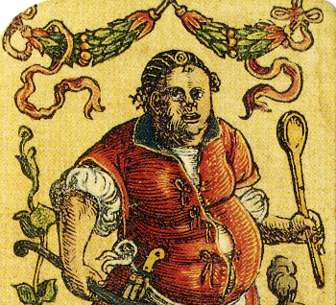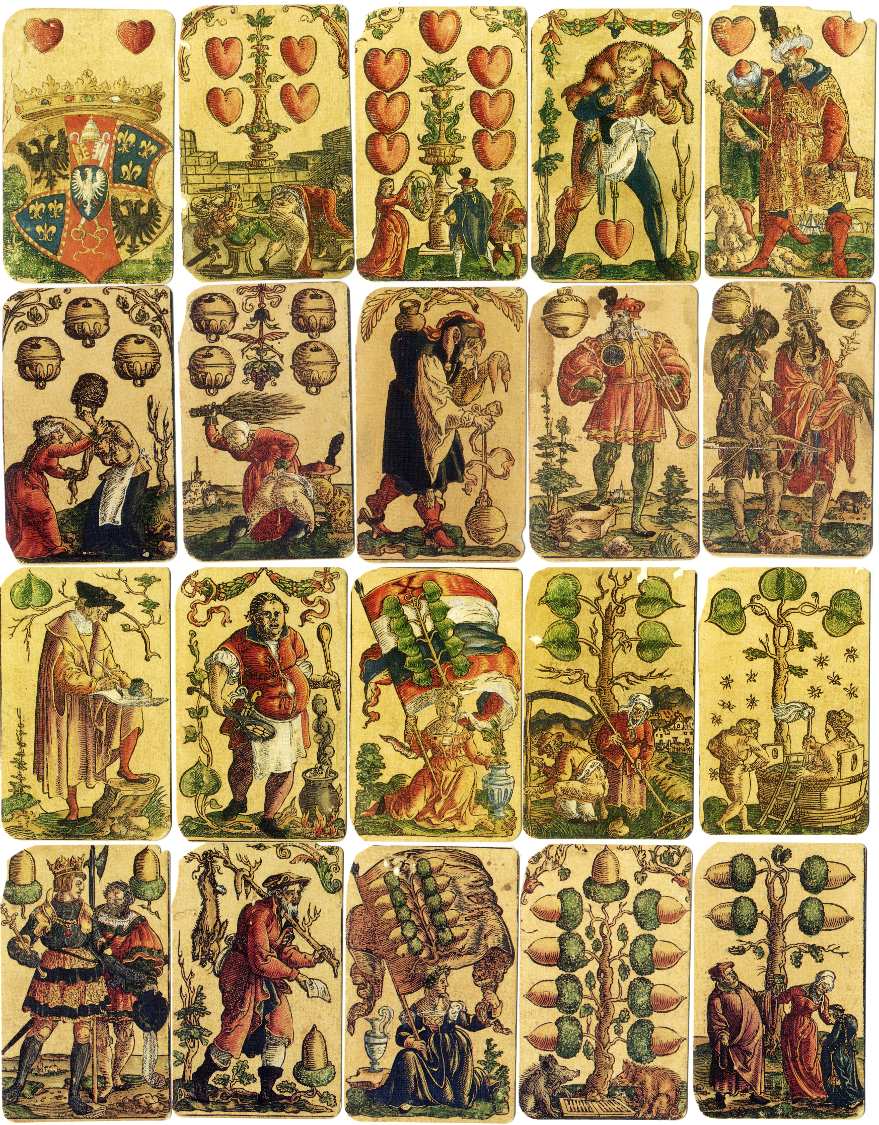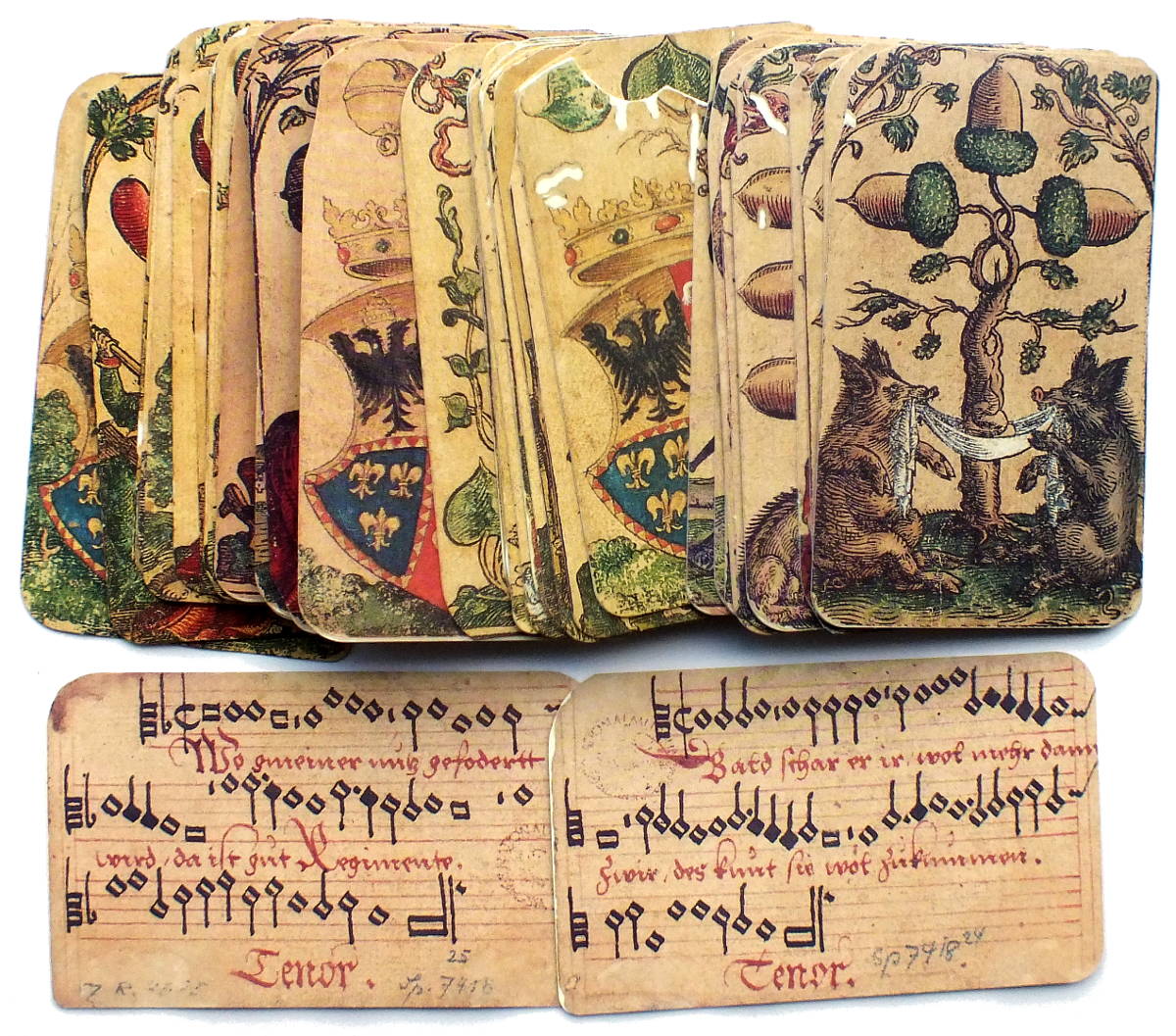Peter Flötner, c.1545
Seven cards from a satirical pack produced by Peter Flötner of Nuremberg, c.1545. The suit symbols are acorns, leaves, bells and hearts. The block-cutter and publisher was Franz Christoph Zell.

Satirical Playing Cards by Peter Flötner, Nuremberg, c.1545
Behind the superficial representation to which one's attention is initially drawn, there is a second one in which Flötner sets irony and parody against the past, against the classical and bourgeois way of life...
Although Nuremberg had no university, towards the end of the 15th century the city became a major centre of humanism in Germany, as well as a centre of trade and skilled craftsmanship. The influence of classical forms and humanism was also mirrored by anti-classical tendencies, so that these playing cards can be seen as a parody or burlesque. The vulgar everyday activities of common folk (e.g. toilet humour and irreverence) is juxtaposed to bourgeois pretentiousness. The art of printing made it possible for art, knowledge and information - including political or social comment - to be made accessible to the common people… in this case thanks to a good block maker.


Above: cards from a satirical woodblock printed and water coloured pack designed by Peter Flöttner of Nuremberg, c.1545. The block-cutter and publisher was Franz Christoph Zell. Gold highlights have been added. The suit symbols are acorns, leaves, bells and hearts and the card values run from deuce, 3,4,5,6,7,8,9,10, Unter, Ober, Künig. The 10s are represented by banners. In the numeral cards the suit symbols have been moved to the upper half of the cards so that the bottom of each card is free for illustration, in what must be one of the most splendid woodblock packs from the first half of the sixteenth century. The backs of the cards contain the vocal scores for German songs. Cards from the facsimile edition published by Ferd Piatnik & Söhne, Vienna, 1993.
Peter Flötner (c.1490-1546) was a German designer, sculptor, and printmaker. He was an important figure in the introduction of Italianate Renaissance design to sculpture and the decorative arts in Germany. Read Wikipedia article →

By Simon Wintle
Member since February 01, 1996
I am the founder of The World of Playing Cards (est. 1996), a website dedicated to the history, artistry and cultural significance of playing cards and tarot. Over the years I have researched various areas of the subject, acquired and traded collections and contributed as a committee member of the IPCS and graphics editor of The Playing-Card journal. Having lived in Chile, England, Wales, and now Spain, these experiences have shaped my work and passion for playing cards. Amongst my achievements is producing a limited-edition replica of a 17th-century English pack using woodblocks and stencils—a labour of love. Today, the World of Playing Cards is a global collaborative project, with my son Adam serving as the technical driving force behind its development. His innovative efforts have helped shape the site into the thriving hub it is today. You are warmly invited to become a contributor and share your enthusiasm.
Related Articles

VEB Kombinat Kali
Advertising pack depicting old means of salt production, with designs by Hannelore Heise.

Burghausen
Historical figures and buildings to promote the town of Burghausen, with designs by Jonny Petri.

Tarock Nr. 71 by Ferd. Piatnik & Söhne
Special tarock deck for the Tyrolean game Droggn.

Wiener Pattern – Nuremberg Version
A classic deck in a new illustrative style, with notable variations in line work, detail, and colour...

CARD-AB Miltenberg
Illustrations by Rita Stern depicting notable landmarks and scenes from the town of Miltenberg in Ge...

New Altenburg Skat cards – German DDR Pattern
Authentic Altenburger Skat cards with German suits (Acorns, Hearts, Leaves, Bells).

German Travel Cards
A travel-themed educational deck helping American tourists visiting Germany.

French Revolutionary cards by Pinaut
Seven cards from a French Revolutionary pack by Pinaut featuring characters from classical antiquity...

Briefmarken-Quartett
Quartet game featuring postage stamps from the Zones of Occupation in post-WWII Germany.

Ukraine playing cards
Historical figures from Ukraine’s past in a familiar Piatnik style.

IG Chemie Papier Keramik
Promotional pack designed by Karl-Heinz Schroers for a German trade union with comical bears on the ...

Engel-Tarot
Set of major arcana designed by Alois Hanslian depicting angels throughout.

Virgil Solis
Remarkable pack of 52 animal-suited playing-cards designed and etched by Virgil Solis.

Pam is the Knave of Clubs
Playing cards as metaphors in 18th century art - from fate, chance and social hierarchy t...

Politiker-Skat by Bubec
Caricatures of world leaders, including many German politicians, by the artist Bubec.

Le Poker Politique
French politicians and various world leaders caricatured by the German artist Bubec.
Most Popular
Our top articles from the past 28 days

